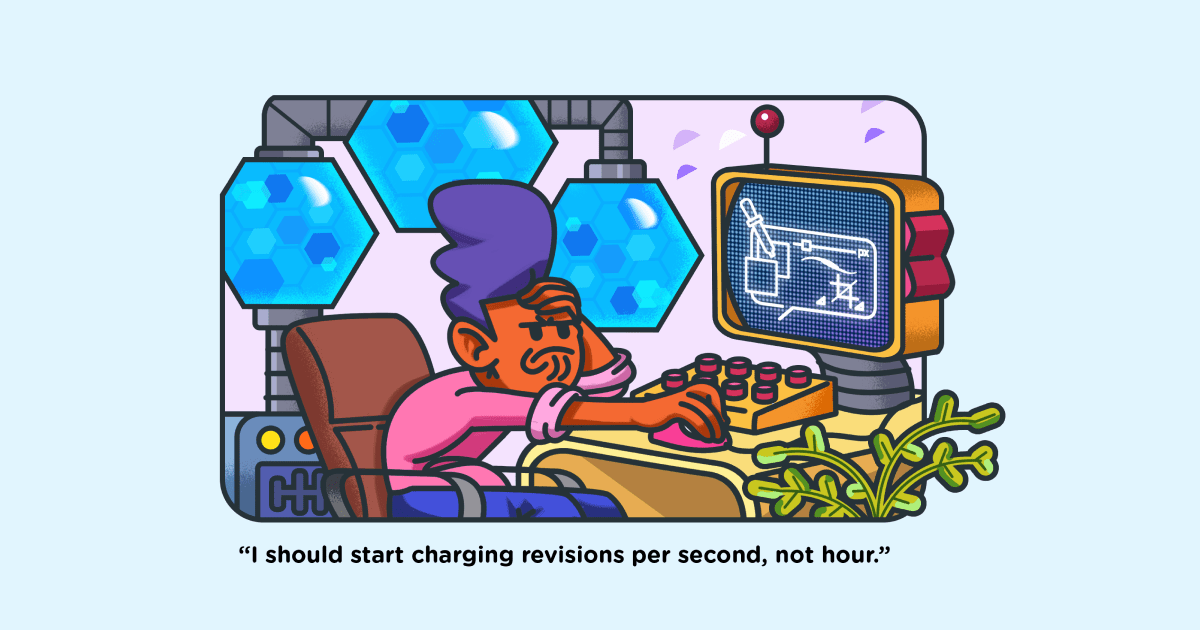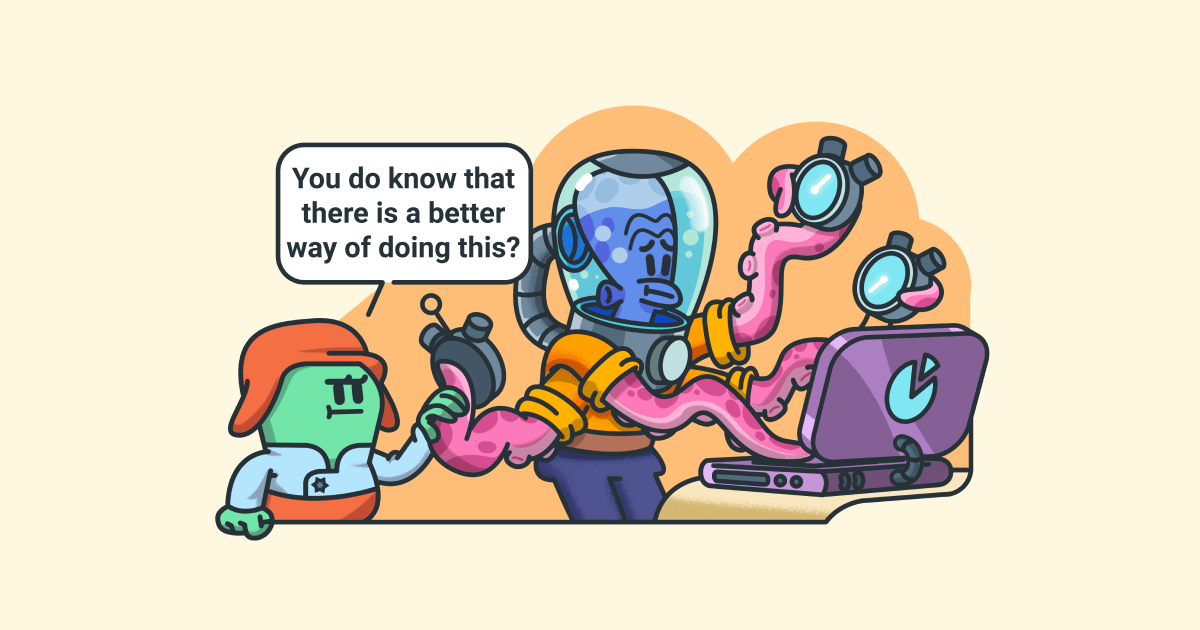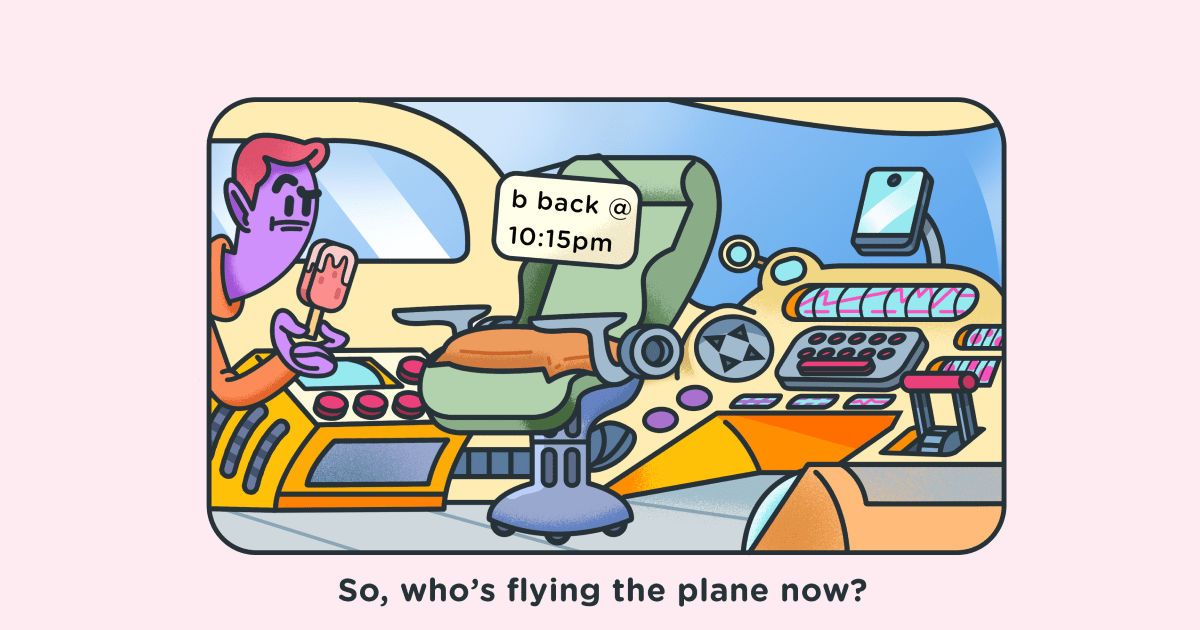The benefits of using a time tracker in a remote team
Last updated on: December 22, 2021
My friend once told me that, when her team was briefly working from home, her boss didn’t believe that they actually worked. Even though the team performed their job the same way they did in an office, her employer was mistrustful. Thus, they soon got back to the office. I should mention that they didn’t track time while working from home.
Why does that matter? Well, when remote employees log their hours, they have proof of their work, so it’s easier to build trust between employers and workers. Apart from an issue of trust, there are other ways how using a time tracker in a remote team is significant.
In this article, we’ll cover time tracking benefits for remote teams, and show you how time tracking in a remote team can work in practice.
Table of Contents
What are the benefits of employee time tracking for remote teams?
Before we start exploring the key reasons remote employees should start tracking time, let’s just remember what remote work encompasses. Remote employees are those who:
- work from home,
- work from coworking spaces, cafés, or other locations that are not offices,
- work from various locations, but occasionally come to the office,
- sometimes have flexible working hours.
Now, here are the benefits of employee time tracking for remote teams.
Accurate billing and payroll
When remote employees work on several projects and for numerous clients, it’s important to track every hour they spend on each project. Moreover, workers need to separate billable hours from non-billable hours, which you can do with a time tracking tool like Clockify. This routing will make billing the clients much easier.
As you can see below, the first time entry is not billable, while others are marked as billable. Here, the task named “Updating portfolio” isn’t assigned to a particular project, which could mean that it isn’t a task done for a client. Therefore, it isn’t billable.

Source: How to calculate billable hours
With the help of a time tracking tool, a remote team will be able to keep track of all billable hours for different clients. As a result, time recording will prevent any miscalculations and secure that invoices are done properly.
Aside from billing purposes, time recording ensures that employees get accurate paychecks. By using a time tracker, remote workers note down what projects they have worked on and for how long. When having such precise work data, employers won’t be able to underpay or overpay their remote workers. Besides, managers can also review whether someone has overtime.
Effective project management
When working remotely, team managers may find it difficult to tell who’s currently dealing with what project within the team. But, if everyone on a team logs their hours, and enters the details about the tasks and projects, work transparency will be much clearer. So, if there are some overwhelmed workers, managers should consider allocating the tasks differently.
In addition, tracking time will help leaders keep an eye on a project’s status. For example, let’s say that you and your team have estimated that the ABC project will take 163 hours to complete. By now, your remote employees have tracked around 14 hours of work. So, you’re still at the beginning because you have another 149 hours to end the project. Or, if you prefer percentages, you’ve completed around 8% of the work, which you can see below.
An example of project status in Clockify
This is the perfect way to learn whether there are going to be any potential delays and prevent these problems if possible. Plus, you can track the progress of each remote team working on a project. In the example above, we can see that the design and QA teams have been quite effective so far.
Remote workplace trust
How can superiors know that their remote employees are working? The most crucial element here is trust, and we’re talking about mutual trust and respect between workers and managers or employers. Time tracking plays a vital role in building trust in a remote workplace.
Think about the time tracker as a glue that connects employees and superiors. Workers have a responsibility to log their hours daily and prove they’re trustworthy. On the other hand, employers and managers need to be trusting and accept employee timesheet data as proof of their remote work.
Freedom of choosing a remote working lifestyle
Some employees have a remote work habit of changing their work location. Apart from their home office, remote workers also do their tasks from coworking spaces, cafés, or libraries. That’s the freedom that comes with remote work.
Let’s say that today, you started your workday at home, but after two hours, you needed a change of scenery. You went to a library and stayed there for three more hours. Now, to keep track of all the assignments you’ve done at home and at the library, you should start time recording. Some time tracking tools, like Clockify, have the option of syncing the data across several devices, such as mobile phones, laptops, and etc.
Source: Free Remote Work & Team Software
If it’s more convenient for you, you can track your library hours on your phone, but your home office hours on your laptop. A time tracker will ensure that all logged hours are saved and synced, regardless of the work location and the devices you use.
Better communication and collaboration
A time tracker can ease communication and collaboration in remote teams. Here’s how: telecommuting employees clock in at the beginning of their workday, which shows their colleagues that they’re currently working. So, it’s easier to clarify who’s available for meetings or chats. In the screenshot below, we can see that Austin and Karen are working at the moment because their tracked time is “In progress.”
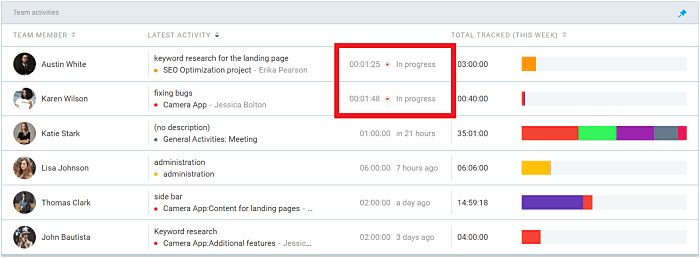
This is especially practical for teams whose members come from different continents or even several time zones. When employees know who’s currently on the clock, they can reach out to those workers if they have a problem or need help.
Speaking of time zones, Clockify allows you to track time regardless of your time zone. For instance, you work from Paris (UTC/GMT +2 hours) and your manager is in Sydney (UTC/GMT +10 hours). Although you’re in different time zones, when your superior evaluates your timesheets, he’ll see these reports in Sydney’s time zone.
Having a better understanding of employee availability improves both remote communication and collaboration.
💡 If you’re looking for some additional advice for remote collaboration and communication, we gathered 50+ working from home tips on these subjects and many more.
Enhanced employee productivity and performance
Remote team members don’t share the same physical space. So, measuring how effective workers are can be a tricky part. The practical way managers can review employee performance and productivity is to analyze employees’ logged hours, as well as other details, like task descriptions and the amount of time spent on a project. Thus, time tracking can help ensure that everything runs smoothly and that remote employees are capable of finishing projects on time.
Aside from leaders, time tracking comes in handy for workers, too. Employees can find out how they spend their time during the day, how productive they are, and what apps they use most.
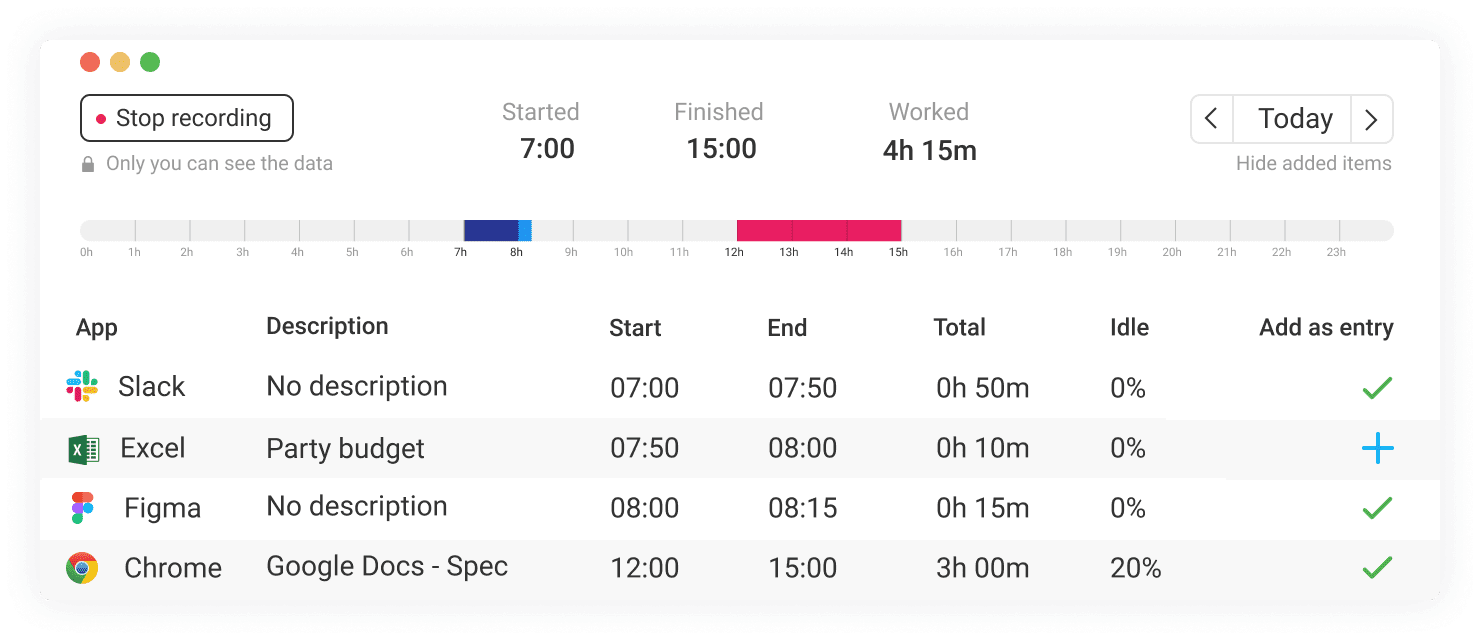
This is an example of the productivity timeline, a handy option that Clockify offers, which shows you how much time you spend working in different apps. To try this feature, you’ll need to use an automatic time tracker. Ensure that this timeline shows only activities longer than 10 minutes. As you can see from the screenshot, this user has tracked three hours in Google Docs. If the user is a content writer, then this is a good score because it shows she’s been writing for three hours (let’s assume that there was no annoying staring at an empty page). The plus sign at the right side of the page allows you to add the time entries that you want. For example, here, all time entries except for Excel have been added.
Improved accountability
How does time tracking help employees hold themselves accountable for their performance? Well, knowing that they need to log their hours makes workers aware that a clock is ticking. So, it’s more likely that employees will do their best to complete their tasks before the deadline. As a result, workers will show how responsible they are. Once all team members prove their accountability, creating a trusting relationship between workers will follow, too.
How can managers monitor remote employees?
Remote leaders shouldn’t act like Big Brother, watching over workers and analyzing every step they make during working hours. By doing so, managers are erasing every trace of trust between them and their employees.
Instead, leaders and employers should find the right approach for tracking the time employees spend performing their tasks remotely. Here are some significant steps superiors can take to monitor remote workers.
Step 1: Create a time tracking guideline
To ensure that remote workers track their time properly, employers or managers should create a time tracking guideline. Even if your company uses a simple time tracking app, consider making such a manual for recording time. Here’s what a guideline needs to cover:
- What tasks or projects do employees have to track?
- Should employees categorize their time entries?
- How should employees track their time (manually, with a timer, entering hours in a timesheet)? If all options are available, let workers know that.
- How often do employees need to log their time (every day, or once per week)?
In addition, it’s important to clarify how detailed these time entries should be. For example, whether it’s fine if employees describe their tasks as “Blog post” or “Writing the blog post ‘How to manage remote teams’.”
Having such a guideline leaves no room for misunderstandings. Employees will know exactly how to log their hours, how often, and how detailed they need to be. Plus, they won’t feel like their privacy is invaded during working hours.
Step 2: Ask your team for updates
As we already mentioned, keeping effective communication among team members is crucial when working remotely. To stay in touch with remote employees, managers should organize regular meetings and ask their team members for updates.
Getting updates from all workers will help leaders find out what each team member is working on and if there are any problems with projects. So, managers will be able to make realistic project estimates.
Now, the frequency of these meetings depends on the work that your team is performing. Sometimes, you’ll need updates once or twice per day, other times you’ll be good with one weekly meeting.
Step 3: Set deadlines
Apart from the updates you get from the team, another way to make sure that everyone is on the same page is to set deadlines for all tasks. Like them or not, deadlines bring structure into a remote work routine. Of course, it’s worth noting that these deadlines have to be realistic.
Once employees get new assignments, followed by start and end times, they’ll be able to organize their work accordingly. Besides, when telecommuting workers have set deadlines, it’s more likely they’ll hold themselves accountable for these tasks. Moreover, having enough time for a task helps workers be less stressed and more productive.
How can remote workers track their hours?
We explained how remote leaders can track their employees, but here are some tips for telecommuting workers.
Track both working hours and distractions
As we mentioned, remote employees should follow a time tracking guideline when tracking the time they work remotely. But, apart from recording hours you spend working on tasks, you can also track distractions. This is especially important for those of you working from home since distractions are one of the most common challenges of remote workers.
So, whenever someone interrupts you, be sure to note down the time you’ve wasted on that distraction. At the end of the day, you’ll have a better idea of how much time you dedicated to your tasks and how much time you wasted on distractions. In addition, you can also write down the time you spent at meetings, if you have frequent meetings.
Track time to find out how different locations impact your work
Now, if you’re one of those workers who take advantage of a remote lifestyle by switching work locations, this tip is for you. Time tracking can help you figure out what locations suit particular types of tasks.
Here’s how that works. Let’s say that your task is writing a blog outline. So, track the time you need to finish this task when working from home. Also, measure how much time it takes you to complete this task at the office. Then, simply compare the results. If you’re more productive with this task at home, be sure not to leave this task for the day when you’re in the office.
By writing down the time entries for every task during the day or a week, you’ll soon realize how much workload you can do at home vs. the office/cafés. Thus, you’ll be able to craft a remote work schedule that best suits your needs.
Conclusion
Tracking time when working remotely will ensure that everything falls into place. With a time tracker, remote teams will manage their projects more effectively and charge their clients properly. Apart from projects, time recording will also help employees communicate and collaborate with each other easily because workers will let others know when they’re on the clock. Working in such an environment will have a positive impact on building trust within a remote team.
To monitor remote employees, managers should make a time tracking guideline for all workers. Besides, leaders should always ask their teams for regular updates and set deadlines for all tasks.
As for telecommuting workers, a time tracker will not only show them how they spend their working hours but also how often they get distracted. Plus, when monitoring time, remote employees will learn how various locations influence their productivity levels.
✉️ Do you use a time tracker when working remotely? If so, how does tracking time help you and your team? Send your answers, suggestions, and comments to blogfeedback@clockify.me and we may include them in this or future posts.

